If you buy through our links, we may earn an affiliate commission. This supports our mission to get more people active and outside.Learn about Outside Online's affiliate link policy
Our 6 Favorite Shoes for New Runners

The best running shoes for beginners include the Asics Nimbus pictured here. (Photo: 101 Degrees West)
So you’ve decided to start running. Congrats! Whether your goal is to get fit, clear your mind, or train for your first race, lacing up a pair of running shoes is the first step toward success. (Seriously. You may be tempted to head out the door in those decade-old Converse–don’t do it! Running will feel much harder and your body will hurt much more than it needs to.)
But with hundreds of running shoe options on the market, buying running shoes can be as daunting as braving your first miles on your neighborhood streets. Add in all the running shoe jargon like midsole, rocker, and stability, and you may be even more confused.
Luckily, we can help. Our 20-plus-person testing team has logged thousands of miles and tested nearly every running shoe on the market, evaluating them for comfort, fit, durability, and beginner-friendly design. We’ve narrowed it down to the top picks that offer the right blend of cushioning, support, and ease of use so you can focus less on your shoes and more on enjoying the run.
At a Glance–6 Best Running Shoes for Beginners
- Asics Nimbus 27 $165
- Brooks Ghost 17 $150
- Asics Kayano 32 $165
- Mount to Coast R1 $160
- Nike Vomero 18 $155
- Topo Magnifly 5 $140
- FAQ for Beginners Buying Running Shoes
Asics Nimbus 27

Weight: 10.8 oz (men); 9.3 oz (women)
Stack Height: 43.5–35.5 mm (men); 42.5–34.5 mm (women)
Drop: 8 mm
| Pros | Cons |
| ⊕ Plush cushioning
⊕ Extra protection for heel strikers ⊕ Wide, stable platform | ⛒ Heavy
⛒ Upper can feel hot |
Best sellers become best sellers for a reason, and the Asics Nimbus 27 is a prime example. Now in its 27th iteration, this time-tested neutral trainer ranks among the best everyday running shoes on the market. From its thick, cushioned sole to its plush upper, every detail is built for durability and long-lasting comfort.
Beneath the heel, a semi-fluid silicone pod adds extra shock absorption, delivering a softer landing for heel strikers. But the real star of the underfoot comfort is the generous layer of foam that strikes a perfect balance between soft and firm, creating a smooth and surprising supportive ride that feels comfortable whether you’re heading out on a frisky short neighborhood loop or tiredly finishing your longest run to date. Asics’ commitment to comfort extends throughout the upper with plush padding around the Achilles and ankle bone.
Brooks Ghost 17
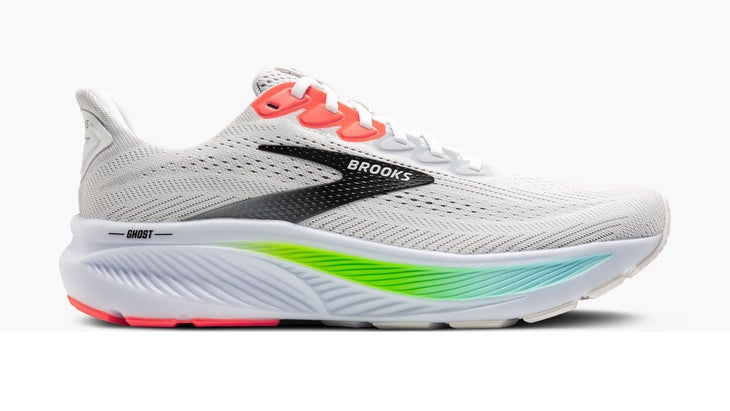
Weight: 10.1 oz (men); 9.0 oz (women)
Stack Height: 36.5–26.5 mm
Drop: 10 mm
| Pros | Cons |
| ⊕ Stable ride
⊕ Durable ⊕ Good balance of cushion and road feel | ⛒ Firmer cushioning |
The Brooks Ghost has long been a go-to, dependable daily trainer. It may not have the newest flashy features, but it delivers precisely what runners need: a reliable, comfortable, no-frills ride that simply does what it needs and nothing more. Underfoot, the cushioning leans more towards the firmer side, which enhances the shoe’s stability, making it ideal for beginner runners who typically need a grounded, secure platform. Grooves carved into the bottom allow for some flexibility in the sole, providing a smooth heel-to-toe transition.
Up top, the engineered air mesh upper offers a breathable, true-to-size fit that keeps your feet comfortably locked in, mile after mile. The Brooks Ghost has earned a reputation as a true workhorse—dependable, durable, and built to handle daily mileage with ease—and the Ghost 17 continues that legacy.
Read our full Brooks Ghost 17 review.
Asics Kayano 32
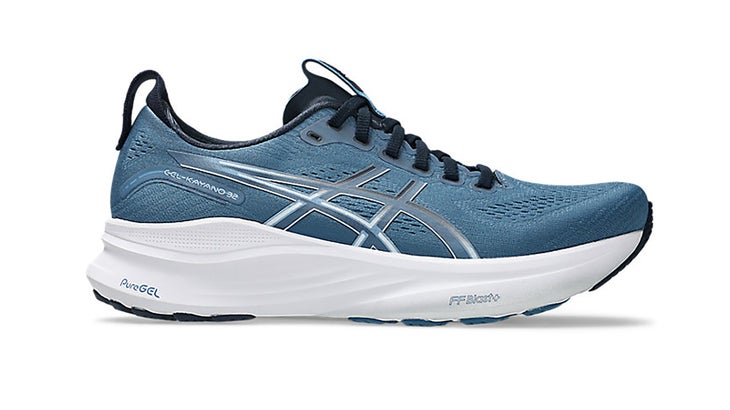
Weight: 10.5 oz (men’s); 9 oz (men’s)
Stack Height: 40–32 mm
Drop: 8 mm
| Pros | Cons |
| ⊕ Strongly supportive
⊕ Ample cushioning ⊕ Plush, secure upper | ⛒ Heavy |
For decades, the Kayano has been a trusted choice for runners seeking extra support. As a stability running shoe, the Kayano 32 provides innovative structure to help prevent the foot from rolling inward excessively, offering a more controlled ride when you need it while not getting in the way when you don’t.
Underfoot, while it leans toward the firmer side, it’s still one of the most well-cushioned stability shoes on the market. There’s ample protection for even the heaviest heel strikers. On the run, it feels plush and smooth, but a tad on the heavy side.
Fitting true to size, the Kayano 32 features an engineered mesh upper that wraps around the foot securely, offering a comfortable, locked-in feel. If you find that most running shoes feel flimsy and tippy, or your feet feel like they collapse, we recommend trying these.
Mount to Coast R1
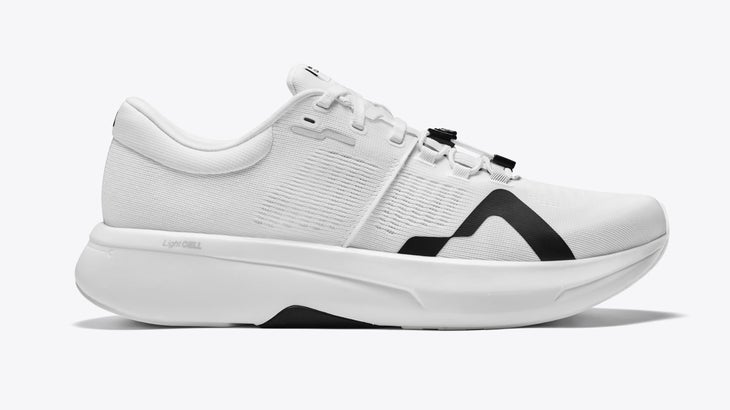
Weight: 8.5 oz (men’s size 9, women’s size 10.5)
Stack Height: 35–27 mm
Drop: 8 mm
| Pros | Cons |
| ⊕ Promotes a flexible, natural stride
⊕ Dual lacing system allows for a more refined fit ⊕ Lightweight | ⛒ Less cushioning than some |
As one of the top up-and-coming running shoe brands, Hong Kong-based Mount to Coast R1 offers beginners a lightweight, daily trainer that’s designed to withstand the abuse from ultra-long distance running, making it extremely durable. Unlike many cushioned shoes that dull your connection to the road, the R1 gives runners a more natural, grounded feeling and stays in tune with your stride, subtly adapting to and supporting your movement rather than controlling it. Whereas most beginner-friendly shoes tend to be relatively heavy, the R1 is refreshingly lightweight, giving it a fast feel.
One unique feature is the independent dual lacing system, which allows you to adjust the lower and upper sections separately for a more personalized fit. It takes a bit of getting used to at first, but once dialed in, it creates a comfortable, secure feel while providing plenty of room for natural toe splay.
Read our full Mount to Coast R1 review.
Nike Vomero 18
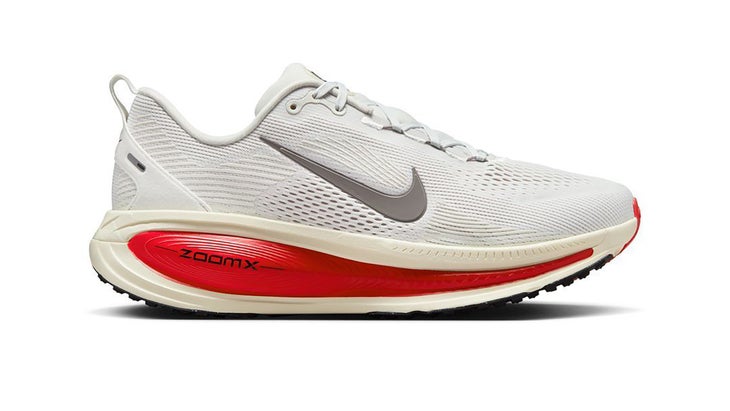
Weight: 11.5 oz (men’s); 9.2 oz (women’s)
Stack Height: 46–36 mm
Drop: 10 mm
| Pros | Cons |
| ⊕ Extremely cushioined
⊕ Plush upper is very comfortable ⊕ Bouncy feel underfoot | ⛒ Heavy |
If the thought of running on a plush bed of pillows sounds appealing, look no further. As the most cushioned option listed here, the Nike Vomero 18 takes cozy, soft comfort to the next level. Stepping into these is like wrapping your feet in a memory foam mattress. Often, shoes with this much soft cushioning underfoot can feel unstable, making them unsuitable for most beginners. However, the Vomero 18 ride is surprisingly stable for such a tall shoe. That said, this much cushion is an acquired taste and may not suit runners who prefer a more grounded, stable feel or a firmer ride.
The plush comfort continues up top with an engineered mesh upper generously padded around the heel and tongue, giving the Vomero 18 a luxurious feel from every angle. The tradeoff for all this cushioning? Weight. It’s the heaviest shoe on our list, something to consider if you’re chasing speed. But for easy miles and daily runs, the comfort more than makes up for the added bulk.
Read our full Nike Vomero 18 review.
Topo Magnifly 5
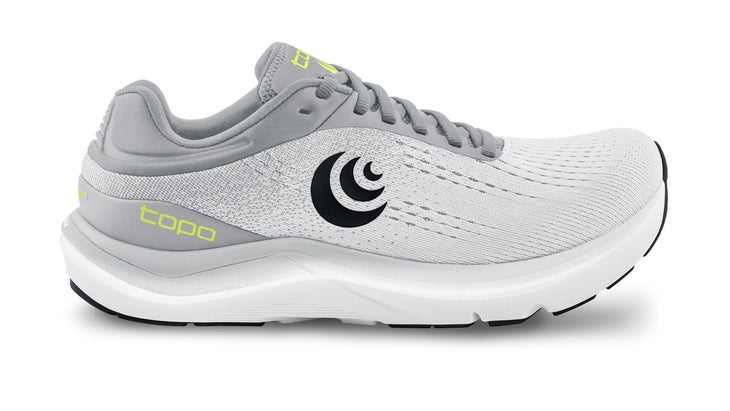
Weight: 8.7 oz (men’s); 7.2 oz (women’s)
Stack Height: 25–25 mm
Drop: Zero drop
For runners who find most shoes too thick underfoot and prefer a more connected, low-to-the-ground feel, the Topo Magnifly 5 delivers. Built on a zero-drop platform, meaning the heel and forefoot sit at the same height, it encourages a more balanced, natural running experience, and when you’re beginning, it can be a good time to develop an efficient stride that will reduce stress on your knees and hips. That said, zero-drop shoes can place additional strain on the Achilles and calves. Transitioning gradually is key if you’ve been running or walking in shoes with higher heels.
One of the best features of Topo is the anatomical toe box that flares under the big toe, allowing more space for your toes to spread out naturally. This shape enables the foot to engage and provide a stable stance and is especially beneficial for runners dealing with bunions or who feel cramped in most running shoes. The simple mesh upper is breathable and does a great job of locking down the midfoot, while allowing the toes to move freely.
| Pros | Cons |
| ⊕ Great ground sensitivity
⊕ Very lightweight ⊕ Ultra-comfortable fit that follows natural foot shape | ⛒ Very little cushioning |
How to Buy Beginner-Friendly Running Shoes
If you’re new to buying running shoes, the sheer number of options can feel overwhelming. Many models may look similar, but even subtle design differences can significantly impact how a shoe feels on your foot.
“One of the first things to nail down is the fit of the shoe. Identify what you like and don’t like about different models,” says David Salas, DPT, and chief contributor at Doctors of Running. He recommends visiting a specialty running store to try on a variety of shoes and get a sense of what works best for you. If that’s not possible, ordering a few pairs to compare at home and returning the ones that don’t feel right is a great alternative.
Prioritize Fit and Comfort
Every running shoe is built a bit differently: some prioritize cushioning over a more grounded feel, others feature wider toe boxes or added padding in the upper. But regardless of the specific features, the most important factor when choosing a running shoe is simple: comfort. “It starts with seeing what you like around your feet,” Salas says. “And then also from a basic cushioning standpoint as well, do you like it really soft, or do you prefer something a little firmer?”
From the moment you slip it on, the shoe should feel right, comfortable enough to wear all day, smooth when walking, secure without being tight, and free of pressure points or hot spots. A proper fit means the shoe gently hugs your foot without squeezing, with roughly a thumb’s width of space between your longest toe and the front of the shoe. If something feels off when you try it on, it’s unlikely to feel better during a run.
Note, however, that comfort on the run is different than step-in comfort: jog around the store and pay attention to how the shoe lands, rolls, and pushes off. Does the movement feel natural or clumsy? Do you feel protected but still grounded, stable and moving forward smoothly? Does it make you smile? Is it a running shoe color you’ll happily wear?
Learn Some Basic Shoe Jargon
If you’re shopping for running shoes online, it helps to understand some basic shoe terminology so you can better identify what you like or don’t like. Here’s a quick breakdown of common running shoe terms and what they mean:
Midsole: This is a layer of foam under your foot. It’s responsible for providing cushioning, responsiveness, and protection. Each brand has its own foam compounds which vary in softness and rebound and can be tuned to provide different rides for different shoes.
Outsole: This is the bottom of the shoe that hits the ground. It’s responsible for providing traction and protecting the midsole from wear.
Upper: The upper is the soft material that surrounds the foot and secures it in the shoe.
Responsive: Refers to how quickly and efficiently a shoe returns energy to your foot after it hits the ground.
Cushioned: A universal term that refers to the amount of foam underfoot and how soft that foam is.
Stack Height: The amount of material (including the outsole, midsole, and sock liner) between your foot and the ground. Stack heights generally range from low teens to as high as 50 millimeters, with most of today’s models falling in the 30–40-millimeter range.
Drop: The difference in height between the heel and forefoot of the shoe. Drop, or off-set, ranges from zero (equal heel and toe height) to around 12 millimeters higher in the heel.
Stability: How well a shoe keeps the foot and ankle upright, especially related to support for reducing excessive inward rolling. Stability shoes have a wide base and often use multiple foams strategically built into the midsole.
Avoid Cheap Models
Almost every brand offers budget-friendly shoes that look like running shoes. However, appearances can be misleading. These models are often made with lower-quality foams and materials that aren’t designed to support the foot and withstand the repeated impact of regular running. They tend to fall short in support, durability, and overall performance. One of the simplest ways to spot the difference? The price. A quality running shoe typically starts around $140.
FAQ
Is walking in your running shoes a bad idea?
In general, yes, walking in your running shoes regularly can reduce their lifespan. Every mile you put on them, whether walking or running, gradually wears down the cushioning, support, and energy return. While walking isn’t as high-impact as running, it still compresses the midsole and contributes to overall wear and tear. If you want your running shoes to last longer and perform their best, it’s smart to reserve them just for runs and use a separate pair for everyday walking.
How long do running shoes last?
Unfortunately, there’s no one-size-fits-all mileage limit. On average, most running shoes last between 200 and 350 miles, depending on factors such as your weight, running style, and the terrain on which you run. The best way to know if it’s time for a new pair is by inspecting them closely, checking for deep creases in the midsole, worn-out rubber on the outsole, or holes and fraying in the upper. If your shoes are showing any of these signs, or just don’t feel as supportive as they used to, it’s probably time to replace them.
Do I need more than one pair of shoes?
You don’t need more than one pair of running shoes, but rotating between different models can offer benefits. Running is a repetitive activity, and using the same shoe every day can reinforce the same stress patterns. Studies have shown that switching things up with a second pair can slightly change your mechanics and reduce the risk of overuse injuries, particularly if your second pair provides a significantly different ride. It also gives your shoes time to recover. The foam in many running shoes can take up to 24 hours to fully rebound after a run. Letting them rest between workouts can help maintain their cushioning and extend their overall lifespan.
How We Tested Good Running Shoes for Beginners
Every running shoe on this list has undergone Outside’s thorough Buyer’s Guide testing process. When available, multiple testers of varying abilities and experience levels evaluated each model based on comfort, fit, ride, and overall performance. Testers rated each shoe on a scale of 1 to 10 and provided detailed feedback. We also reached out to a Doctor of Physical Therapy for his advice on the best running shoes for beginners. Lead tester Cory Smith then combined these insights with his own hands-on experience to curate the final selections.